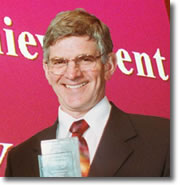Graham
Shepherd (June 1995 - Feb 1997)
|
|
In 1995 when the end of the century was in sight Telstra started looking
around for someone to run the Labs and lead the transition from one century
to the next. Graham Shepherd and Hugh Bradlow joined at the same time,
Hugh Bradlow to lead the technology programme and Graham Shepherd to lead
the transformation.
|
In Graham's own words ......
"A hundred or more flies form a dense mat on the only damp
patch of dust for twenty kilometres. The mat lifts sluggishly and then drops
back down again when a human hand passes over the top to get a cooling mug of
water from the tank tap. A crow, sensing water, perches on one leg on the antenna
tower, watching warily, changing legs every few seconds to cope with the burning
steel. A hundred metres away a heron, also sensing water, flaps slowly in a
low, wide circle around the site. Max Murrie and I lie on our bunk beds, perspiration
drying instantly to a salty crust. We are all waiting, hoping, for some relief
from the 50 degree heat.
We were camped at Wigunda on the edge of the Nullarbor Plain testing
microwave radio reception under the extreme conditions of the coastal desert
for a new broadband link between Adelaide and Perth. Our tests produced daunting
results which TRL gurus like John Murphy, Reg Coutts, Garth Jenkinson and Sasti
Sastradipradja pored over for weeks grunting and hypothesising as is their wont.
Of course, as is also their wont, they triumphed in the end with a design proposal
which enabled the new radio relay system to go through, connecting Perth and
the rest of the world to the Intellectual Powerhouse at Clayton, Victoria.
I first became aware of the Research Labs when I was a student
at Adelaide University. TRL was the premier destination for the cream of the
crop but you needed more degrees than a thermometer on the Nullarbor. Every
young student of my era aspired to follow in the footsteps of young einsteins
like Bernie Smith, Harvey Sabine and Tony Bundrock. After graduation I joined
Telecom in Adelaide working in radio communications and eventually moving to
Melbourne. If working at TRL was not initially for me, at least I could rub
shoulders with genius every now and then.
While TRL continued to light the way in telecommunications my
own career moved on. Eventually I left Telecom in 1983 and spent 12 years with
various companies developing and selling electronic networks and systems to
governments and industry.
In 1995 when the end of the century was in sight Telstra started
looking around for someone to run the Labs and lead the transition from one
century to the next and then some. Hugh Bradlow and I joined at the same time,
he to lead the technology programme and I to lead the transformation.
This was a period of trial-by-fire for the Labs and its always-dedicated
staff as they faced the challenge of a massive change in focus and direction.
But, as always, TRL came through and is now leading Telstra into a new era of
technology innovation and transition from carriage provision to content and
service provision.
TRL has led the way in forging new value solutions on the Internet
for Telstra, particularly linking Telstra's businesses to provide very compelling
propositions for customers. Internet telephone calling, directory and web click-to-dial,
very fast approximate spelling search routines. As Julie Andrews sang, "These
are a few of my favourite things!" Web directories, multi-media solutions,
packet wireless solutions, business modelling, human factors analysis and, of
course, network engineering in every technology to help drive costs and value.
Out of the desert into the crisp mountain air."
< Back to History of TRL page
Last updated: 5 July 2001
